Podcast
Questions and Answers
What is a gear train?
What is a gear train?
Two or more interconnected gears.
What does a gear mechanism offer?
What does a gear mechanism offer?
A mechanical advantage.
What does MA stand for?
What does MA stand for?
Mechanical advantage
What does a gear offer?
What does a gear offer?
Mating and meshed gears rotate in the same direction.
Mating and meshed gears rotate in the same direction.
What is an input gear?
What is an input gear?
What does an idler gear do?
What does an idler gear do?
What is the formula for gear ratio (GR)?
What is the formula for gear ratio (GR)?
If the gear ratio is less than 1, the speed is greater than the torque.
If the gear ratio is less than 1, the speed is greater than the torque.
If a big gear drives a small gear, speed increases.
If a big gear drives a small gear, speed increases.
If a small gear drives a big gear, torque increases.
If a small gear drives a big gear, torque increases.
Flashcards
Gear Train
Gear Train
Two or more interconnected gears that transmit force.
Mechanical Advantage (MA)
Mechanical Advantage (MA)
The ratio of output force to input force in a system.
Input Gear
Input Gear
The gear where force enters the gear train.
Output Gear
Output Gear
Signup and view all the flashcards
Idler Gear
Idler Gear
Signup and view all the flashcards
Gear Ratio (GR)
Gear Ratio (GR)
Signup and view all the flashcards
Speed Relationship
Speed Relationship
Signup and view all the flashcards
Torque Relationship
Torque Relationship
Signup and view all the flashcards
Mating Gears
Mating Gears
Signup and view all the flashcards
Force Calculation
Force Calculation
Signup and view all the flashcards
Study Notes
Gears and Gear Ratios
- A gear train is two or more interconnected gears.
- Gears offer a mechanical advantage, increasing speed, power, or force.
- They can also change rotational direction.
- Gear ratio (GR) is calculated as the number of teeth on the output gear divided by the number of teeth on the input gear.
- A higher gear ratio means a greater change in speed or torque.
- If the input gear is larger than the output gear, the output speed will increase and torque will decrease. Conversely, a smaller input gear compared to a larger output gear will decrease output speed and increase torque.
Gear Types
- Input Gear: The gear that receives the force.
- Output Gear: The gear that transmits the force.
- Idler Gear: Changes the rotational direction.
Mating/Meshing Gears
- Mating (meshed) gears rotate in opposite directions.
Gear Ratio Calculations
- Gear Ratio (GR) = Number of teeth on output gear / Number of teeth on input gear
- Example: If output gear has 20 teeth and input gear has 10 teeth, GR = 20/10 = 2
- Speed: Big >> small = speed increases, small>>big = speed decreases.
- Torque: Big >> small = torque decreases, small >>big = torque increases.
Studying That Suits You
Use AI to generate personalized quizzes and flashcards to suit your learning preferences.




